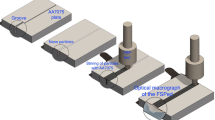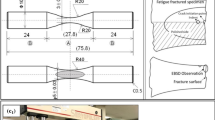Abstract
This study demonstrated nanoindentation techniques of investigating the effects of size and feature in a microstructure on the mechanical properties of thixoforged aluminum alloy. Mechanical properties and tribological characteristics of rheology-forged Al2024 wrought aluminum alloy in terms of T6 heat treatment were investigated by varying the aging time by nanoindentation and nanoscratch techniques. By nanoindentation/nanoscratch tests and atomic force microscopy, it was demonstrated that the 4-h aged material exhibited the highest hardness because of the intermediate precipitate phase θ″, which was precipitated by T6 heat treatment. Moreover, the friction coefficients in the precipitates in the eutectic phase region were lower than those in the primary α phase region.
Similar content being viewed by others
References
Chryssolouris G, Stavropoulos P, Tsoukantas G, Salonitis K, Stournaras A (2001) Nanomanufacturing processes: a critical review. Int J Mater Prod Technol 21(4):331–348 doi:10.1504/IJMPT.2004.004946
Ji S, Fan Z, Bevis MJ (2001) Semi-solid processing of engineering alloys by a twin-screw rheomoulding process. Mater Sci Eng A 299:210–217 doi:10.1016/S0921-5093(00)01373-3
Adachi M, Sato S sasaki H, Harasa Y, Maeda T, and Ishibash N (2002) The effect of casting condition for mechanical properties of cast alloys made with new rheocasting process. Proc. of the 7th Int. Conf. on Semi-Solid Processing of Alloys and Composites, pp. 629–634.
Sun D, Sun XC, Northwood DO, Sokolowski JH (1996) Thermoelectric power characterization of a 2024 aluminum alloy during solution treatment and aging. Mater Charact 36:83–92 doi:10.1016/1044-5803(96)00002-2
Sen N, West DRF (1969) Some factors influencing precipitation in Al–Cu–Mg and Al–Mg–Cu–Ag alloys. J Inst Met 97:87–92
Edwards GA, Stiller K, Dunlop GL, Couper MJ (1998) The precipitation sequence in Al–Mg–Si alloys. Acta Mater 46(11):3893–3904 doi:10.1016/S1359-6454(98)00059-7
Jung HK, Kang CG (2000) Rheating process of cast and wrought aluminum alloys for thixo-forming and their globularization mechanism. J Mater Process Technol 104:244–253 doi:10.1016/S0924-0136(00)00576-8
Seo PK, Kim DU, Kang CG (2007) The effect of the gate shape on the micro-structural characteristic of the grain size of Al–Si alloy in the semi solid die casting. Mater Sci Eng A 445–446:20–30 doi:10.1016/j.msea.2006.06.133
Kang CG, Seo PK, Jeon YP (2005) Thixo die casting for fabrication of thin type component with wrought aluminum alloy and its formability limitation. J Mater Process Technol 162–163:59–69 doi:10.1016/j.jmatprotec.2004.03.032
Shen W, Mi L, Jiang B (2006) Characterization of mar/scratch resistance of coating with a nano-indenter and a scanning probe microsope. Tribol Int 39:146–158 doi:10.1016/j.triboint.2005.04.023
Wang XY, Zhang H, Li DY (2004) Characterization of lubricated worn surface using a nano/micro-indenter. Mater Sci Eng A 371:222–228 doi:10.1016/j.msea.2003.11.049
Qian L, Li M, Zhou Z, Yang H, Shi X (2005) Comparison of nano-indentation hardness to microhardness. Surf Coat Tech 195:264–271 doi:10.1016/j.surfcoat.2004.07.108
Huang L, Lu J, Xu K (2004) Elasto-plastic deformation and fracture mechanism of a diamond-like carbon film deposited on a Ti-6Al-4V substrate in nano-scratch test. Thin Solid Films 466:175–182 doi:10.1016/j.tsf.2004.03.026
Wellman RG, Dyer A, Nicholls JR (2004) Nano and micro indentation studies of bulk ziroconia and EB PVD TBCs. Surf Coat Tech 176:253–260 doi:10.1016/S0257-8972(03)00737-0
Oliver WC, Pharr GM (1992) An improved technique for determining hardness and elastic modulus using load and displacement sensing indentation experiments. J Mater Res 7:1564–1583 doi:10.1557/JMR.1992.1564
MTS Systems. Nanoindenter®XP, manual
Dao M, Chollacoop N, Van Vliet KJ, TA Venkatesh TA, S Suresh S (2001) Computational modeling of the forward and reverse problems in instrumented sharp indentation. Acta Mater 49:3899–3918 doi:10.1016/S1359-6454(01)00295-6
Bucaille JL, Stauss S, Felder E, Michler J (2003) Determination of plastic properties of metals by instrumented indentation using different sharp indenters. Acta Mater 51:1663–1678 doi:10.1016/S1359-6454(02)00568-2
Fischer-Cripps AC (2002) Nanoindentation. Mech Eng Series. Springer, Berlin, Germany
Author information
Authors and Affiliations
Corresponding author
Rights and permissions
About this article
Cite this article
Cho, S.H., Kang, C.G. & Lee, S.M. Development of evaluation technique for microcharacteristics of thixoforged wrought aluminum alloy by nanoindention and atomic force microscopy. Int J Adv Manuf Technol 42, 892–909 (2009). https://doi.org/10.1007/s00170-008-1650-y
Received:
Accepted:
Published:
Issue Date:
DOI: https://doi.org/10.1007/s00170-008-1650-y




